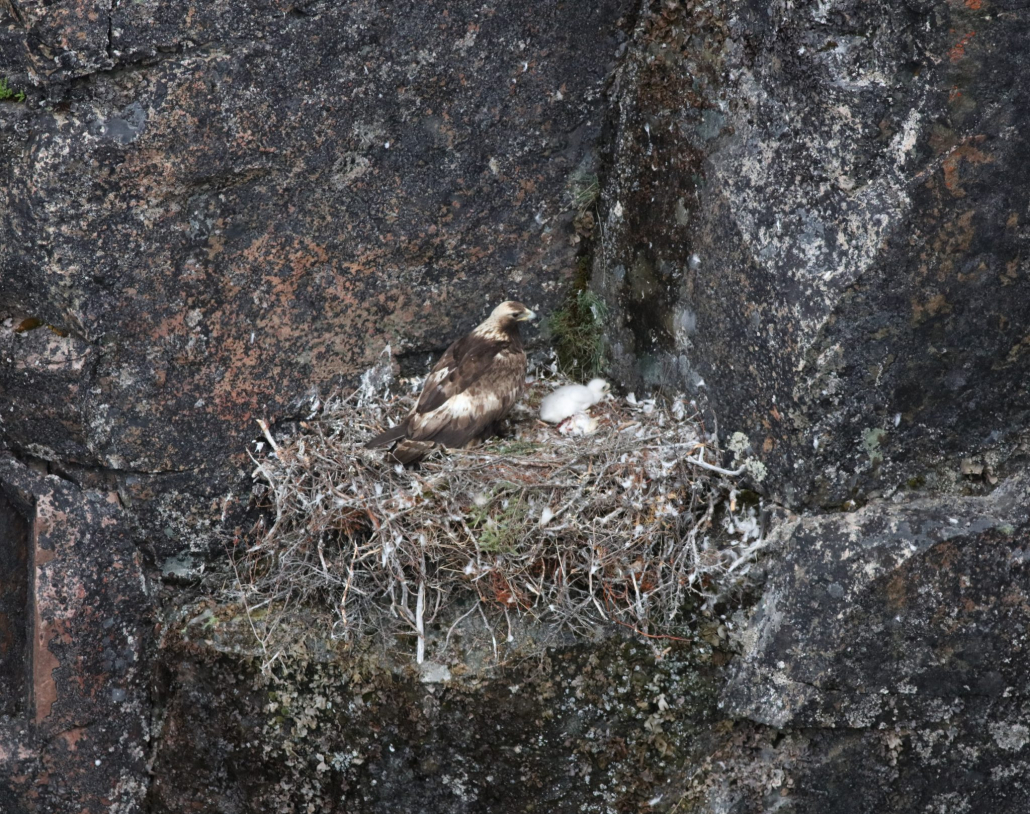 During the 20th century, the Golden Eagle (Aquila chrysaetos) population decreased significantly in North America, mostly due to human activities such as hunting, trapping and disturbance. In 2005, the species was designated as “vulnerable” in Québec in accordance with the Loi sur les espèces menacées ou vulnérables (RLRQ, c. e-12.01). Of the whole breeding population of Eastern North America, more than 60% nest in northern Québec. This means the Nunavik region is essential to maintain healthy population of golden eagles. Given the uncertainties in the population trends (EROPQ, 2020), the recovery plan put in place for the Golden Eagle was extended for another 10 years (2020-2030).
During the 20th century, the Golden Eagle (Aquila chrysaetos) population decreased significantly in North America, mostly due to human activities such as hunting, trapping and disturbance. In 2005, the species was designated as “vulnerable” in Québec in accordance with the Loi sur les espèces menacées ou vulnérables (RLRQ, c. e-12.01). Of the whole breeding population of Eastern North America, more than 60% nest in northern Québec. This means the Nunavik region is essential to maintain healthy population of golden eagles. Given the uncertainties in the population trends (EROPQ, 2020), the recovery plan put in place for the Golden Eagle was extended for another 10 years (2020-2030).
The project presented here is led by the Ministère de la faune, de la forêt et des parcs (MFFP) in collaboration with Canadian Wildlife Service (CWS-ECCC). It aims to address different objectives from the recovery strategy mentioned above. Amongst others, it is to explore areas with a high nesting potential but with no data recorded to this day, in order to get an accurate estimation of the Golden Eagle breeding population size in Nunavik and other parts of northern Quebec. The first year of this project focuses on the Hudson Bay Area, and the MFFP aims to conduct a second year of research in the Hudson Strait.
The whole project will further allow to have a better understanding of the range of distribution of Golden Eagle in Nunavik.

photo © Alexandre Anctil, MFFP

 During the 20th century, the Golden Eagle (Aquila chrysaetos) population decreased significantly in North America, mostly due to human activities such as hunting, trapping and disturbance. In 2005, the species was designated as “vulnerable” in Québec in accordance with the Loi sur les espèces menacées ou vulnérables (RLRQ, c. e-12.01). Of the whole breeding population of Eastern North America, more than 60% nest in northern Québec. This means the Nunavik region is essential to maintain healthy population of golden eagles. Given the uncertainties in the population trends (EROPQ, 2020), the recovery plan put in place for the Golden Eagle was extended for another 10 years (2020-2030).
During the 20th century, the Golden Eagle (Aquila chrysaetos) population decreased significantly in North America, mostly due to human activities such as hunting, trapping and disturbance. In 2005, the species was designated as “vulnerable” in Québec in accordance with the Loi sur les espèces menacées ou vulnérables (RLRQ, c. e-12.01). Of the whole breeding population of Eastern North America, more than 60% nest in northern Québec. This means the Nunavik region is essential to maintain healthy population of golden eagles. Given the uncertainties in the population trends (EROPQ, 2020), the recovery plan put in place for the Golden Eagle was extended for another 10 years (2020-2030).
 Phase III of assessing cumulative impacts in east Hudson Bay.
Phase III of assessing cumulative impacts in east Hudson Bay.  Arctic tern is a key species of the Arctic ecosystem and is an important bird species for Inuit in Nunavik, who consume tern eggs and who use terns as indicators of important biological areas. Over the last few years, Inuit from various communities in Nunavik have reported that Arctic tern numbers are in decline and have expressed concerns about this situation. Scientific surveys conducted in some areas of the Canadian and circumpolar Arctic also suggest that the tern population may be reduced now, compared to what it was in the past. Inuit in Nunavik have highlighted the need for more research on this subject.
Arctic tern is a key species of the Arctic ecosystem and is an important bird species for Inuit in Nunavik, who consume tern eggs and who use terns as indicators of important biological areas. Over the last few years, Inuit from various communities in Nunavik have reported that Arctic tern numbers are in decline and have expressed concerns about this situation. Scientific surveys conducted in some areas of the Canadian and circumpolar Arctic also suggest that the tern population may be reduced now, compared to what it was in the past. Inuit in Nunavik have highlighted the need for more research on this subject.